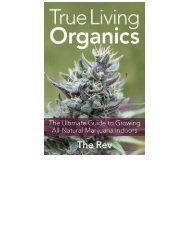You also want an ePaper? Increase the reach of your titles
YUMPU automatically turns print PDFs into web optimized ePapers that Google loves.
understand what true organics means. Call the manufacturers directly if you have doubts, and be<br />
direct with them. Ask them if they have any synthetic chelating elements in their fertilizer. Chelating is<br />
pronounced like key-layting, just so you sound serious. Always avoid products that use the term<br />
“Organic Based” because in my experience this almost always means that the product contains<br />
Synthetic Chelating Salts, which are very bad. If you see the phrase “Made with organic or natural<br />
nutrients” be very wary <strong>to</strong>o. <strong>The</strong> bottle should state that the product is made with 100% or all-natural<br />
or organic nutrients/elements. It also needs <strong>to</strong> have the OMRI tag on it clearly visible. I trust any<br />
nutrients with this tag on them for use with TLO gardening.<br />
With TLO growing you really never need a lot of liquid nutrients, and I have about 4 on hand at all<br />
times. I’ll list them below for you, with some info relating <strong>to</strong> why and when I use them.<br />
Fox Farm’s Big Bloom<br />
I love this nutrient as it is essentially an organic tea made with bat guano and earthworm castings,<br />
along with many other good things. Take note of the NPK (Nitrogen, Phosphorous and Potassium<br />
respectively) numbers, because they are very low in comparison <strong>to</strong> many liquid organic nutrients; this<br />
is a good thing. If need be, you could use this at a ratio of ½ cup per gallon of water, but I use it in<br />
teas at a ratio more like ⅓ cup per gallon.<br />
Organic Gem Fish Fertilizer<br />
This product is all natural with great NPK numbers for an all-purpose liquid TLO nutrient. <strong>The</strong> N-P-<br />
K numbers on this one are great, at 3-3-0.3—and sometimes I like <strong>to</strong> use this one when I have vegging<br />
plants in the same container for <strong>to</strong>o long between transplants. Normally for me it’s a tea additive only,<br />
and a great one at that. In teas I use it at either 2 teaspoons per gallon, or if used as a flowering stage<br />
tea, something more like 1 tablespoon per gallon. For an all-purpose plant booster dosage, I would<br />
say use it about every 3rd watering, at about 2 teaspoons per gallon.



